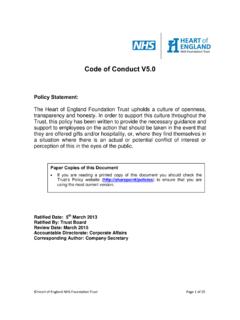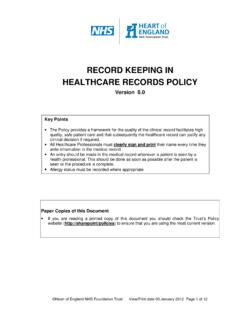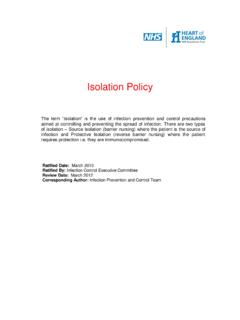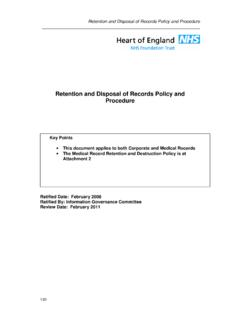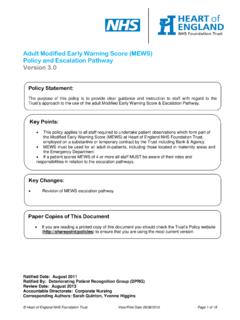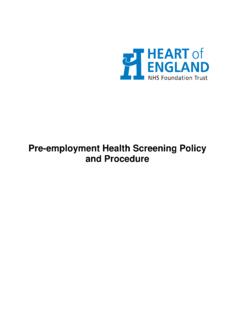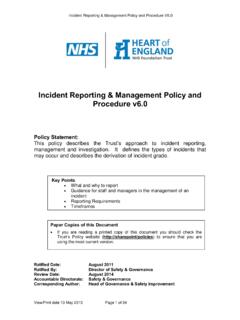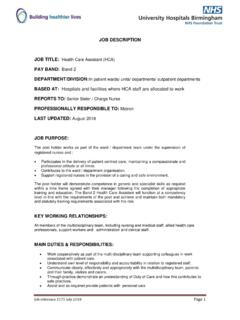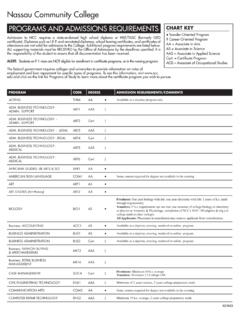Transcription of Guidelines for Patient Self-Administration of Medicines
1 Page 1 of 20 Guidelines for Patient Self-Administration of Medicines Issue Date: 24/08/2017 Controlled Document Number: 578 Version No: Guidelines for Patient Self-Administration of Medicines CATEGORY: Procedure CLASSIFICATION: Clinical PURPOSE To inform all practitioners of their responsibilities when initiating, supervising or discontinuing the Self-Administration of Medicines by patients Controlled Document Number: 578 Version Number: Controlled Document Sponsor: Chief Pharmacist Controlled Document Lead: Chief Pharmacist Approved By: Medicine Management Advisory Group On: November 2014 Review Date: November 2017 Distribution: Essential Reading for: Medical Practitioners Pharmacists Medicines Management Technicians Registered Nurses CONTROLLED DOCUMENT Page 2 of 20 Guidelines for Patient Self-Administration of Medicines Issue Date: 24/08/2017 Controlled Document Number: 578 Version No.
2 Contents Paragraph Page 1 Introduction 3 2 Aim of Self-Administration of Medicines 3 3 Levels of Self-Administration of Medicines 3 4 Selection of Individual Patients for Self Medication 4 5 Selection of Medicines Suitable for Self Administration 6 6 Self-Management of Diabetes 7 7 Prescribing Medicines for Self Administration 8 8 Dispensing Medicines for Self Administration 9 9 Safe Storage of Medicines for Self Administration 9 10 Safe Management of Patient Drug Locker Keys 9 11 Teaching and Supervision 10 12 Documentation of Drug Administration 11 13 Monitoring Patients who are Self-administering Medicines 11 14 Withdrawal from the Self Administration Programme 12 15 Untoward Incidents 13 16 Monitoring Self administration of Medicines 13 17 References/ Bibliography 13 Appendices Appendix A Self- Administration of Medicines Assessment Form 16 Appendix B Ongoing daily Self Administration Assessment Record 18 Appendix C Patient Agreement To Self Administer Medicines At Level 2 Or 3 Consent Form 19 Appendix D Self Administration Of Medicines Flowchart 20 Page 3 of 20 Guidelines for Patient Self-Administration of Medicines Issue Date: 24/08/2017 Controlled Document Number: 578 Version No: 1.
3 Introduction The National Institute for Health and Clinical Excellence (2009) estimated that between 33% and 50% of Medicines prescribed for long term conditions may not be taken by patients as recommended. This represents a health loss for the patients and an economic loss for society. Self-Administration of Medicines by hospital in-patients is considered an important part of treatment. It allows a Patient to receive education about their medication and increases the chances of concordance after discharge. It also permits recognition of the Patient s own capabilities and encourages a positive attitude to medication on discharge, or during a rehabilitation programme.
4 The principles of Medicines management within the Trust Medicines Policy and associated procedures (Current version) must be adhered to at all times. The flowchart in Appendix D provides a summary of the Self-Administration of Medicines process. 2. Aim of Self-Administration of Medicines To promote and maintain the Patient s independence in managing their Medicines prior to discharge from hospital empowering them to participate in their own care and practice taking their Medicines under close supervision. To offer continuous support and education and promote Patient safety. To improve concordance to maximise the benefits gained by patients from prescribed Medicines and therefore reducing re-admissions due to non-concordance.
5 To promote simplified medication regimes 3. Levels of Self-Administration of Medicines The Nursing and Midwifery Council (2010) describe the following 3 levels of self- administration of Medicines . Level 1 The registered nurse is responsible for the safe storage of the medicinal products and the supervision of the administration process ensuring the Patient understands Page 4 of 20 Guidelines for Patient Self-Administration of Medicines Issue Date: 24/08/2017 Controlled Document Number: 578 Version No: the medicinal product being administered. This is traditional nurse administration. However, if a Patient is self- administering controlled drugs this is the only level which permits them to do so, due to the storage requirements.
6 Level 2 The registered nurse is responsible for the safe storage of the medicinal products. At administration time, the Patient will ask the registrant to open the cabinet or locker. The Patient will then self-administer the medication under the supervision of the registrant. Level 3 The Patient accepts full responsibility for the storage and administration of the medicinal products. The registered nurse checks the Patient s suitability and compliance verbally. The level of Self-Administration must be documented in the Patient s notes by the registered practitioner assessing the Patient . 4. Selection of Individual Patients for Self Medication Self-medication is designed for patients who are expecting to be able to take their own Medicines with little or no support in the home environment following discharge.
7 Patients will be selected from one of the following categories: Patient requests to self-medicate Patients identified by a registered practitioner who are non-compliant due to, for example, a lack of understanding about their Medicines and need the opportunity to learn in a safe environment. Contraindications for self-medication include: Patients with unstable dosage regimes; Patients who have a known or possible risk of self harm; and Patients who have capacity but are unwilling to participate in self administration Limitations for self-medication include: Page 5 of 20 Guidelines for Patient Self-Administration of Medicines Issue Date: 24/08/2017 Controlled Document Number: 578 Version No: Patients who are confused or have a cognitive impairment must never be given custody of their own medication but may self-administer at Level 2 with nurse supervision with an aim to progress to Level 3 if the acute confusion is resolved.
8 And Patients under the age of 16. The policy and procedures for the admitting of patients under the age of 19 must have been followed. The doctor or registered nurse looking after the Patient , in conjunction with the ward pharmacist or registered pharmacy technician will be responsible for assessing the Patient s understanding, knowledge and practical ability to be responsible for administering their own drugs. The risk assessment must be documented on the Self- Administration of Medicines Assessment Form (Appendix A) and the Patient must then sign the Patient Agreement to Self-Administer Medicines Consent Form (Appendix C). The Patient s ability to read the label and open bottles/foil packs will be assessed and if required, alternative arrangements will be made by the pharmacist/ technician .
9 The patients understanding of which drugs to take and when. The drug actions, dosage, frequency, possible side effects, how to take and any specific instructions will be assessed and documented on the Self- Administration of Medicines Assessment Form (Appendix A). For all patients self medicating at Level 3, the Consultant responsible for their care must sign the Self- Administration of Medicines Assessment Form (Appendix A). Once assessed as competent, patients may self-administer (Levels 2 and 3) any Medicines that they have previously administered to themselves at home. In addition new oral, topical, intravenous, subcutaneous and per rectum (PR) Medicines may be self-administered provided the Patient is able and willing to do so.
10 Patients may be assigned at two levels if a Patient is self-administering their oral medication at Level 3 and are also prescribed subcutaneous insulin that they may be unhappy to administer themselves (Level 1). In this case, the registered nurse, pharmacist or pharmacy technician must document both levels in the medical notes. All patients identified for Self-Administration of Medicines must Page 6 of 20 Guidelines for Patient Self-Administration of Medicines Issue Date: 24/08/2017 Controlled Document Number: 578 Version No: receive an explanation from the registered nurse /pharmacist/pharmacy technician and be given the Patient Self-medication Information Leaflet. In addition, Patient s self-administering insulin may be required to keep a home glucose monitoring diary to help them determine what dose of insulin may be required.
